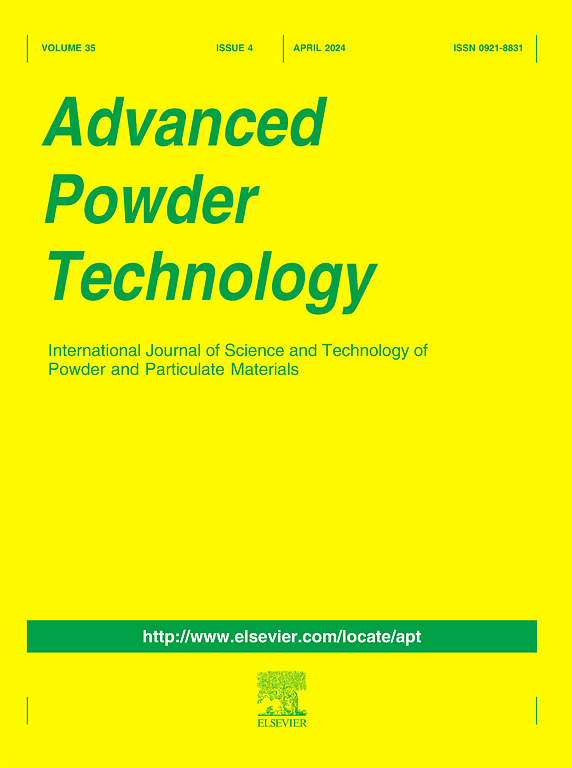Silica-coated NiPt core-shell nanoparticles stable to Ni Oxidation and aggregation
IF 4.2
2区 工程技术
Q2 ENGINEERING, CHEMICAL
引用次数: 0
Abstract
Magnetic particles with a size of dozens of nanometers or less have excellent operability under external magnetic fields and are required to be chemically stable and resistant to aggregation. Owing to their excellent properties, magnetic fine particles have applications in medical imaging, hyperthermia treatment, solid-phase extraction, and recording media. However, pure metal nanoparticles aggregate or oxidize, necessitating the development of a simple method to suppress these phenomena. In this study, NiPt and SiO2-coated NiPt (NiPt/SiO2) nanoparticles were fabricated and characterized. Metallic Ni nanoparticles were synthesized in water exposed to air using Ni(II) acetate tetrahydrate, hexachloroplatinate(IV) hexahydrate, hydrazine, and poly(sodium 4-styrenesulfonate) as the Ni and Pt sources, reducing reagent, and stabilizer, respectively. The simultaneous reduction of Ni and Pt cations afforded NiPt nanoparticles. The NiPt nanoparticles (9.7 ± 3.3 nm) were significantly smaller than the Ni particles synthesized using hydrazine as a reducing reagent (∼300–600 nm). The Pt nuclei were generated faster than the Ni nuclei because of the difference in their standard electrode potentials. The NiPt/SiO2 nanoparticles were synthesized by adding a tetraethylorthosilicate/(3-aminopropyl)triethoxysilane/ethanol solution to the NiPt nanoparticle colloidal solution. They did not aggregate during 24 h of the silica-coating process, whereas the uncoated NiPt nanoparticles were ionized and significantly aggregated over the reaction time of 24 h. The saturation magnetization values of the uncoated NiPt and NiPt/SiO2 nanoparticles were 28.0 and 56.9 emu/g-Ni, respectively, which indicated that the silica coating prevented particle aggregation and controlled Ni oxidation on the surface of the metallic NiPt nanoparticles during the synthesis process. The present work contributes to the advancement of methods for synthesizing colloidally stable metal nanoparticles and synthesis environments.

二氧化硅包覆NiPt核壳纳米粒子对Ni的氧化和聚集具有稳定性
粒径在几十纳米或更小的磁性颗粒在外磁场下具有良好的可操作性,并且要求其化学稳定性和抗聚集性。由于其优异的性能,磁性细颗粒在医学成像、热疗、固相萃取和记录介质中有着广泛的应用。然而,纯金属纳米颗粒聚集或氧化,需要开发一种简单的方法来抑制这些现象。在本研究中,制备了NiPt和二氧化硅包覆NiPt (NiPt/SiO2)纳米颗粒并对其进行了表征。以四水合乙酸镍(II)、六水合六氯铂酸(IV)、肼和聚4-苯乙烯磺酸钠分别作为Ni和Pt源、还原剂和稳定剂,在暴露于空气中的水中合成了金属Ni纳米颗粒。同时还原Ni和Pt阳离子得到NiPt纳米颗粒。NiPt纳米颗粒(9.7±3.3 nm)明显小于以肼为还原剂合成的Ni颗粒(~ 300-600 nm)。Pt原子核的生成速度比Ni原子核快,因为它们的标准电极电位不同。在NiPt纳米颗粒胶体溶液中加入四乙基硅酸盐/(3-氨基丙基)三乙氧基硅烷/乙醇溶液,合成了NiPt/SiO2纳米颗粒。在24 h的反应过程中,NiPt和NiPt/SiO2纳米粒子的饱和磁化强度分别为28.0 emu/g-Ni和56.9 emu/g-Ni,这表明在合成过程中,二氧化硅涂层阻止了NiPt纳米粒子的聚集,控制了Ni在金属NiPt纳米粒子表面的氧化。本文的工作有助于提高胶体稳定金属纳米颗粒的合成方法和合成环境。
本文章由计算机程序翻译,如有差异,请以英文原文为准。
求助全文
约1分钟内获得全文
求助全文
来源期刊

Advanced Powder Technology
工程技术-工程:化工
CiteScore
9.50
自引率
7.70%
发文量
424
审稿时长
55 days
期刊介绍:
The aim of Advanced Powder Technology is to meet the demand for an international journal that integrates all aspects of science and technology research on powder and particulate materials. The journal fulfills this purpose by publishing original research papers, rapid communications, reviews, and translated articles by prominent researchers worldwide.
The editorial work of Advanced Powder Technology, which was founded as the International Journal of the Society of Powder Technology, Japan, is now shared by distinguished board members, who operate in a unique framework designed to respond to the increasing global demand for articles on not only powder and particles, but also on various materials produced from them.
Advanced Powder Technology covers various areas, but a discussion of powder and particles is required in articles. Topics include: Production of powder and particulate materials in gases and liquids(nanoparticles, fine ceramics, pharmaceuticals, novel functional materials, etc.); Aerosol and colloidal processing; Powder and particle characterization; Dynamics and phenomena; Calculation and simulation (CFD, DEM, Monte Carlo method, population balance, etc.); Measurement and control of powder processes; Particle modification; Comminution; Powder handling and operations (storage, transport, granulation, separation, fluidization, etc.)
 求助内容:
求助内容: 应助结果提醒方式:
应助结果提醒方式:


